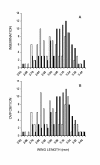Behavioural determinants of gene flow in malaria vector populations: Anopheles gambiae males select large females as mates
- PMID: 12296972
- PMCID: PMC140138
- DOI: 10.1186/1475-2875-1-10
Behavioural determinants of gene flow in malaria vector populations: Anopheles gambiae males select large females as mates
Abstract
Background: Plasmodium-refractory mosquitoes are being rapidly developed for malaria control but will only succeed if they can successfully compete for mates when released into the wild. Pre-copulatory behavioural traits maintain genetic population structure in wild mosquito populations and mating barriers have foiled previous attempts to control malaria vectors through sterile male release.
Methods: Varying numbers of virgin male and female Anopheles gambiae Giles, from two strains of different innate sizes, were allowed to mate under standardized conditions in laboratory cages, following which, the insemination status, oviposition success and egg batch size of each female was assessed. The influence of male and female numbers, strain combination and female size were determined using logistic regression, correlation analysis and a simple mechanistic model of male competition for females.
Results: Male An. gambiae select females on the basis of size because of much greater fecundity among large females. Even under conditions where large numbers of males must compete for a smaller number of females, the largest females are more likely to become inseminated, to successfully oviposit and to produce large egg batches.
Conclusions: Sexual selection, on the basis of size, could either promote or limit the spread of malaria-refractory genes into wild populations and needs to be considered in the continued development and eventual release of transgenic vectors. Fundamental studies of behavioural ecology in malaria vectors such as An. gambiae can have important implications for malaria control and should be prioritised for more extensive investigation in the future.
Figures



References
-
- Breman JG, Egan A, Keutsch GT. The intolerable burden of malaria: a new look at the numbers. Am J Trop Med Hyg. 2001;64:iv–vii. - PubMed

